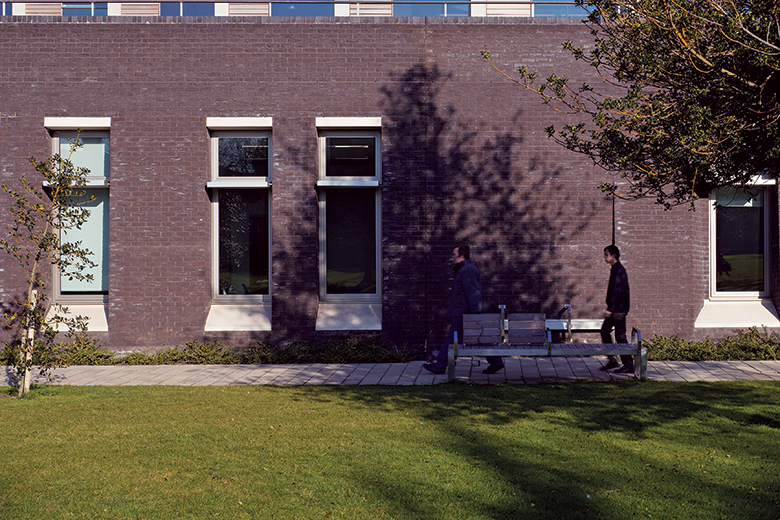Exactly two years ago, Liz Morrish had the unenviable task of explaining to a group of undergraduates why their favourite lecturer could no longer teach them.
There was no question of resorting to half-truths. Her absent colleague, who was on sick leave for stress, had briefed Morrish to talk about the relentless pressure on academic staff at universities.
“I told the students that there are research expectations – including things like ‘grant capture’ – with very low probabilities and yet real consequences for scholars who don’t meet them for whatever reason,” she recalls. “That’s not to mention other expectations like teaching load, marking and the rapidity of feedback,” she adds.
The students were “horrified” to learn that the work of lecturers was being judged by what Morrish calls “a totalising and de-contextualised set of metrics”, which made academics feel more like “players in some academic version of The Hunger Games , where capricious gamemakers change the rules all the time”.
Morrish, whose disclosure to students resulted in disciplinary action culminating in her resignation, is by no means alone in her belief that increased pressures on university staff are triggering more mental health problems. It may be the psychological problems of undergraduates that regularly capture the headlines, but recent studies suggest that their teachers may also be at risk.
In August 2017, a report by RAND Europe, titled Understanding Mental Health in the Research Environment, claimed that the majority of university staff find their job stressful, with levels of burnout comparable to those among “high risk” groups such as healthcare workers.
Some 37 per cent of academics reported a mental health disorder, while more than 40 per cent of postgraduate students reported depression symptoms, emotional or stress-related problems or high levels of stress, according to the report, which was commissioned by the Royal Society and the Wellcome Trust and was based on a literature review of 48 studies in this area.
Undergraduates, it seems, are capable of being very sympathetic about these problems. A few hours after Morrish had outlined the pressures faced by academics, a group of students turned up at her office laden with coffee and cakes. Young people whom she barely knew outside the classroom “offered more humanity and understanding than the managers who are charged with a duty of care to prevent workplace stress”, she recalls. The day this all happened? Ironically, it was University Mental Health Day, which this year falls on 1 March.
Metrics, in particular, are often singled out as a trigger for the stresses that academics face. Since Morrish quit, the establishment of the teaching excellence framework has increased the pressure on UK academics to achieve good scores in the National Student Survey, which feeds into the TEF. However, at researchintensives at least, the greater emphasis arguably remains in the area of research. In September 2014, pressure to secure grant money apparently led Stefan Grimm, a toxicology professor at Imperial College London, to take his own life. He had received a letter earlier that year informing him that he was “struggling to fulfil the metrics of a professorial post” and needed to win research grants worth £200,000 a year.
One month after his death, colleagues at Imperial were shocked to receive an email purportedly sent by the scientist himself. It was titled “How professors are treated at Imperial College” and read: “This is not a university anymore but a business”, where “the rest of us are milked for money, be it professors for their grant income or students who pay £100 just to extend their write-up status”.
In the wake of Grimm’s death, Imperial ordered an internal review of its staff policies, which recommended several changes. These included providing improved support for those facing performance management assessments, which can also take in the number and publication venues of papers each academic produces, as well as the number of PhD students they have supervised.

Is it fair, however, to blame metrics for the apparent prevalence of mental health issues among academics? Or is something else going on? Susan Guthrie, co-author of the RAND Europe study and research leader at the corporation, says many of the challenges found in academic environments also exist in other workplaces. There is, however, “something about the way the different factors come together in academia which is particularly challenging”.
The Health and Safety Executive’s framework on management standards helps to explain why, she says. It identifies six key aspects of work that can affect workers’ stress levels – work demands, level of job control, change of management, work relationships, support provided by managers and colleagues and clarity about one’s role. Higher education staff “report poor well-being across all six of those areas”.
Job insecurity, in particular, is key. “Whether you’re working on a zero hours contract in a call centre or in academia, it’s a stressful thing either way – and there’s evidence that universities are increasingly using [such contracts],” Guthrie says.
It can also be stressful to fulfil the multiple demands of a typical job in academia – “trading off the admin requirements with the research and the teaching, and trying to juggle those different responsibilities and commitments”, Guthrie says.
On the other hand, “Academics get a lot of rewards from the intrinsic intellectual stimulation and challenge of their work and feel that it is valuable,” she says. “So while they may have a high level of job stress, they may also have a high level of job satisfaction.”
So does she think there is currently a mental health crisis among university staff?
“A crisis indicates there’s a new phenomenon. But there is actually evidence going back quite some time to suggest that higher education is a stressful place to work,” Guthrie says, due to the “challenges in the nature of the work and the workplace”.
For one London-based early career researcher, who is paid hourly to lecture at three universities, the lack of job security is one persistent source of anxiety.
“The biggest issue is the additional stress of being constantly broke or having just enough [money] but not enough ever to get comfortable,” she tells THE, under condition of anonymity.
Her current teaching contract is due to end in early May, so she is now looking for another job to tide her over until the start of the next academic year.
Stress is caused by “having to look ahead while also doing all the other stuff that we’re expected to do as academics – writing, providing student support and answering emails. There’s just not enough time,” she says, adding that the situation “creates constant low-level stress”. Well-meaning suggestions that she develop strategies to ease these worries simply avoid the real problem, she adds. “I just say ‘I’ve been on Prozac for 15 years now. A little bit of yoga is not going to make it all better.’”
As a sufferer of chronic pain that sometimes requires her to take time off work, she also worries that her occasional absences may have consequences.
“If I’m ill, I’m very aware that if I take more than a couple of days off, I risk not getting asked back.”
Another stress factor is that she does not have access to the same support and facilities that permanent staff members take for granted – such as office space. “You’re very much expected to come in, teach and then disappear again,” she says.
The same problems are faced by many other postgraduate teachers, but a few studies suggest that it is PhD students who may have the toughest deal of all.
In 2015, researchers at University of California, Berkeley published the Graduate Student Happiness & Well-Being Report, which indicated that almost half (47 per cent) of PhD students at the institution reached 10 out of 30 points on a scale measuring depression, compared with 37 per cent of master’s students.
And a more recent Belgian study, involving 3,659 PhD students, revealed that more than half (51 per cent) experienced symptoms of psychological distress, while 32 per cent were found to be at risk of developing a psychiatric disorder. The most common symptom was feeling under constant strain – experienced by 41 per cent of PhD students, according to the paper, “Work organization and mental health problems in PhD students”, published in Research Policy in May 2017. Other prevalent symptoms were unhappiness and depression (30 per cent) and sleeping problems caused by worries (28 per cent).
Katia Levecque, professor of industrial relations at Ghent University and one of the study’s authors, has been receiving calls on a daily basis from PhD students, faculty and policymakers since the study was published online. “People have given personal, often heartbreaking, testimonies,” Levecque says. “What is also apparent is the feeling of powerlessness. Many have seen the signs of mental health problems, but didn’t feel well equipped to [seek help].”
One doctoral candidate studying at the University of Oxford identifies the shock of going from a fast-paced, high-intensity master’s programme to a PhD as one of the reasons for the deterioration in her mental health. “No one really prepares you for the unstructured days – however hard you try to structure them,” the student, who does not wish to be named, tells THE. “So, welcome to anxiety and depression – and Netflix bingeing.”
Managing your own research project can also be very lonely and dispiriting, she adds.
“For me, despite having a strong community of other doctoral students in my department, it was so easy to fall off the radar and hide, because I no longer had the constant assessment of a BA or an MSc to confirm I was doing well and to squash my niggling impostor syndrome.”
Why didn’t she discuss the problems she was having with her supervisor? At the time, she says, she didn’t want to be thought of as weak. A year on, however, she is feeling much better – thanks, in part, to help from the university’s counselling service and her GP.

The UK-based University Mentoring Organisation (UMO) is one of the few initiatives that provides specialist support to PhD supervisors and their students, and there is now “greater recognition of the emotional impact of undertaking [a doctorate]”, according to its director, Anna Matthews. “I do feel this has been a neglected area.”
She believes that the kind of mentoring the organisation offers needs to be more systemically integrated into higher education institutions, and last year Universities UK took steps towards this end. In September, it launched the Step Change framework, which will help institutions to adopt mental health and well-being as strategic priorities.
The framework, which is currently being piloted at three UK universities, recommends that they work closely with the NHS to consider how mental health services should be commissioned and delivered to student populations.
“What it allows universities to do is look not just at what they’re doing within a university environment, but also to consider how they then interact with external agencies,” says Steve West, chair of UUK’s Mental Health in Higher Education Working Group and vice-chancellor of the University of the West of England, which is leading the trial.
At UWE, students – both at undergraduate and postgraduate level – have access to counselling, as well as a Nightline service, among other initiatives. But what provision is there for academics?
“We offer an external employer support-line, offering counselling that is completely independent from the university,” says West. In general, however, the university expects staff to go to their GPs, he says.
Given the strains within the NHS, this is not ideal, he acknowledges, adding that the university is exploring the possibility of offering in-house counselling for staff. But there are funding problems. “The difficulty”, he says, “is diverting student fees into areas in the university that students could argue are not directly helping them.”
Asked whether he believes that academics are under more pressure than ever before, he responds: “There have always been pressures on academics to deliver [but] the thing that’s changed is the pace because of technology.” And “student expectations are changing massively in terms of what they expect universities to be able to provide”, he adds.
West’s observation about the longevity of the problem is borne out by historical research. A paper on “The well-being of the UK academy, 1998–2004”, published in Quality in Higher Education in 2006, found that around half of all academics and academic-related staff had levels of depression, anxiety and cognitive dysfunction at which some intervention is recommended (known as “caseness”).
A more recent survey, Work-related wellbeing in UK Higher Education – 2014, puts the figure at 55 per cent. The co-author of both reports, Gail Kinman, professor of occupational health psychology and director of the Research Centre for Applied Psychology at the University of Bedfordshire, says the comparatively high levels of mental health problems among academics are linked to several factors related to the demands and social isolation of their roles.
“Perfectionism is also a key driver of poor mental health,” she says. Academics are expected to meet consistently high standards across several areas of work…and often have excessively high self-expectations that are hard to maintain.”
Kinman’s later study, co-authored with Siobhan Wray, a senior lecturer in research methods at York St John University, found that the majority of academics would be reluctant to disclose feelings of depression or anxiety to line managers.
“It is essential to reduce this stigma and provide support at an early stage to stop work-related stress from escalating into more serious mental health problems,” she says. “Multi-level approaches are needed where stress is measured and managed like any other workplace hazard and action is taken at institutional and department level to reduce the risks. Staff also need guidance on self-care and work-life balance, particularly on how to set boundaries and manage email in a healthy way.”
Meanwhile, an Australian study published as long ago as 2003, titled, “Occupational stress in Australian university staff: results from a national survey”, found that caseness rates among the country’s academics stood at 43 per cent, compared with 37 per cent of general university staff and just 12 per cent on the general Australian population.
Merlin Crossley, deputy vice-chancellor (academic) at the University of New South Wales, believes that a more radical approach to academic mental health has become necessary. In his opinion, universities need publicly to acknowledge how the changes occurring within higher education are impacting on the mental health of their staff.
“I’m not sure that quick fixes – mindfulness, resilience training, self-help online courses, increased counselling and professional support – will be effective in themselves,” he says. “Rather, the underlying causes should be discussed.”
One of the chief causes, he believes, is that in an age of increased transparency, accountability and global competition, universities are under increasing pressure to be more productive.
“While some welcome the increased transparency, it should be acknowledged that for some, the constant surveillance of performance is more like the Eye of Sauron,” he continues.
“Once upon a time, it was enough to be a valued member of your cloistered community. Today, one has to show evidence of productivity in a competition that may involve everyone in the world. And in this digital age, no past error or lapse in productivity is forgotten.”
That said, universities can’t be “monasteries free of taxpayer scrutiny. So it’s a matter of adjusting and being reasonable about expectations on staff.”
Recognising the limits of metrics would be “a healthy starting point, but one can’t just publish research citation numbers and student satisfaction survey results and ignore all the things that are not numerically measurable”. Meanwhile, Crossley says, “if people are hurting, we have to listen and try to understand that hurt – and how to lessen it”.

For the majority of students, university is a highly enjoyable experience – a unique opportunity to push themselves intellectually, make new friends and live away from home for the first time.
For many, however, student life is less happy; anxieties about coursework and exams, feelings of loneliness or alienation and money worries can trigger stress and anxiety, leading to mental illness.
In 2016, more than 15,000 first-year students at UK universities disclosed a mental health condition to their tutors or university support staff, a five-fold increase on 10 years earlier, according to the Institute of Public Policy Research. Over the same period, the number of student suicides in England and Wales has doubled, accounting for nearly 150 deaths in 2016. John De Pury, assistant director of policy at Universities UK, says student mental health is the “biggest generational challenge” of our age. “If we get this right, this could be the greatest thing universities achieve in the next couple of decades,” he says.
The UK is not the only country where this phenomenon is becoming more pressing. Hugh Brady, vice-chancellor of the University of Bristol, has held academic positions in Dublin, Toronto and Boston. “Talking to colleagues in all those cities, [they are] seeing the exact same trend,” Brady tells THE.
At his own university, seven students have taken their lives in the past 18 months. For Brady, who is a trained physician, there is “not just increased awareness [of the problem], but a real increase in the incidence of mental health challenges affecting the student body”. And he wants more students to open up about mental health issues, in response to Bristol’s investment of £1 million extra in enhancing student welfare support.
Recent research confirms Brady’s experience that poor student mental health is on the rise across the world. A report commissioned by the Canadian Alliance of Student Associations, titled Breaking Down Barriers: Mental health and Canadian post-secondary students, published in January, found that 44 per cent of Canadian students surveyed felt “so depressed it was difficult to function”. One in 12 US college students makes a suicide plan, according to data on campus suicide and depression compiled by Neumann University, Pennsylvania. “Student mental health is a universal problem,” says Nikhil Govind, associate professor at Manipal Academy of Higher Education, in the Karnataka province of western India. In India, students face especially high family expectations regarding academic performance, which can impact upon well-being, says Govind. If a student discloses symptoms of poor mental health, they can often be met with comments such as “how can you self-harm; think about how your mother would feel” or “you are studying at a good university; you have no reason to feel this way”, he explains.
The problem is exacerbated by the fact that Indian universities are often reluctant to take responsibility for providing care for student mental health and look for alternative explanations for stress, such as bad parenting, family pressures or drug or alcohol abuse, Govind adds.
Only if a student’s grades go seriously downhill would a university feel it necessary to offer support, he says. Manipal, a private university with about 28,000 students, is bucking the trend, however: it has established a confidential student centre with resident psychologists and therapists to ensure that students have a safe place to go. Hundreds of students have signed up in the past nine months, which was wholly unexpected because of the stigma around mental health conditions, Govind says.
In the US, mental health support centres on campus are far more common, but many of them are understaffed and waiting times are lengthy, says Jean Twenge, professor of psychology at San Diego State University who co-authored a widely cited 2017 paper on suicide rates among teenagers and their potential link to social media use.
“I know of one case where a student was handed a list of off-campus therapists [because she had run out of her number of sessions],” says Twenge, who points out that many college students “don’t have a car because they live on campus and many of them don’t have the funds to pay for external appointments”.
Twenge’s study, titled Increases in Depressive Symptoms, Suicide-Related Outcomes, and Suicide Rates Among U.S. Adolescents After 2010 and Links to Increased New Media Screen Time, found a correlation between depression and excessive social media use. Meanwhile, a report titled Status of Mind published by the UK’s Royal Society for Public Health and the Young Health Movement in May 2017, found that use of Instagram, Snapchat, Facebook and Twitter exacerbated body image worries, sleep problems and feelings of anxiety, depression and loneliness in young people.

The rise in mental ill health among UK students is a consequence of issues such as the increased importance of gaining a “good degree”, growing financial pressures, political upheaval around Brexit and an uncertain job market, says Sir David Bell, the vice-chancellor of the University of Reading. However, the arrival of the term “snowflake generation” implies a “deficit” in today’s students, which he dismisses. “They have to be arguably stronger [than ever] – the pressures [that students] have to face are even more complicated than they have ever been,” Bell says. “And even the most resilient person at times, not just at university, will face difficulties,” he adds.
Action is more important than identifying the myriad causes behind today’s problem, believes Bell. “We could spend a lot of time agonising about the why of all this – I’m actually more interested in what we do to enable our students to cope well,” he says.
In the UK, the so-called “cliff edge” in mental health provision is a key concern; last September, writing for THE, health secretary Jeremy Hunt identified the transition point between children’s and adults’ mental health services at the age of 18 – around the time when most students begin their first year – as an issue for the current referral system. This will be tackled by Universities UK’s Step Change project.
Another issue is universities’ perceived over-reliance, in their responses to the student mental health challenge, on one-off publicity campaigns to raise awareness of their support services – especially when those services are struggling to cope with the existing volume of requests for counselling or therapy. Abbie Jessop, a second-year student who chairs Bristol’s student well-being network, says more could be done to improve pastoral support from tutors. “All the campaigns are brilliant but a lot more has to be done on the personal front to increase student engagement levels,” she says.
Universities might also need to rethink their communication strategies, adds Jessop, who is sceptical that university posts on Twitter or Facebook are read by students. “Reducing the amount of communication but making it more specific and putting it in the right areas can help,” she advises.

How it feels: students’ experiences of mental health conditions
Karl Knights experienced symptoms of depression from the age of 14, but his condition deteriorated rapidly when he started at the University of Kent.
Within weeks of arriving at its Canterbury campus, he was displaying a lack of interest in his course, missing lectures and losing weight. But when Knights, now a third-year student, was sectioned under the Mental Health Act his university stepped up to provide the support that he needed, he says.
“While I was in hospital, the university was great and told me to just focus on myself and not to think about work,” he says. When Knights returned to university after several months, he was given an Inclusive Learning Plan, which detailed his condition and the various symptoms that lecturers and tutors should look out for and how they could adapt their teaching to his needs.
Knights believes, however, that staff could have been better equipped to recognise his symptoms in the first instance. His long-term depression may have also been exacerbated by the anxiety of moving to university, as well as the alcohol-fuelled party culture that is often part of the first year of university.
Consulting with students more widely may also help to improve mental health support on campus, he says. “You need a two-pronged approach [which involves] mental health first aid training for staff and within student unions,” he says.
Vicky Taylor suffered severe depression during her second year at Aberystwyth University after a prolonged experience of stress and anxiety.
Now in her fourth year, she still has both “good and bad days”, despite having received treatment.
Taylor did not disclose her difficulties to her university in her first year and even when her symptoms worsened in her second year she kept silent as she did not want to admit that her mental health had declined or to be treated differently, she recalls.
However, returning to Aberystwyth for her fourth year, after a sandwich year in industry, she contacted student support, which offered her counselling and directed her to mental health mentors. She has applied for special circumstances because of a mental health decline over exams, but has not yet received the verdict.
When she recently contacted the union’s wellness officer about her concerns about mental health support at the university, she was told possible changes could be discussed but that ultimately there was no funding for large-scale investment.
“There needs to be more funding overall – for example, counselling services have waiting lists that are months long,” says Taylor. She adds that many students prefer to disclose to their personal tutor, but it is a “lottery” as to whether that person has “any awareness of mental health [or] any empathy or if they understand how to correctly signpost to support services”.
It would also be useful to provide more peer-led mentoring or group sessions led by a member of the well-being team, Taylor adds. “Having a mental health condition can be a very lonely place – it means so much to discuss the experience with a peer who understands exactly what you have been going through,” she says.
Seeta Bhardwa
Register to continue
Why register?
- Registration is free and only takes a moment
- Once registered, you can read 3 articles a month
- Sign up for our newsletter
Subscribe
Or subscribe for unlimited access to:
- Unlimited access to news, views, insights & reviews
- Digital editions
- Digital access to THE’s university and college rankings analysis
Already registered or a current subscriber? Login








